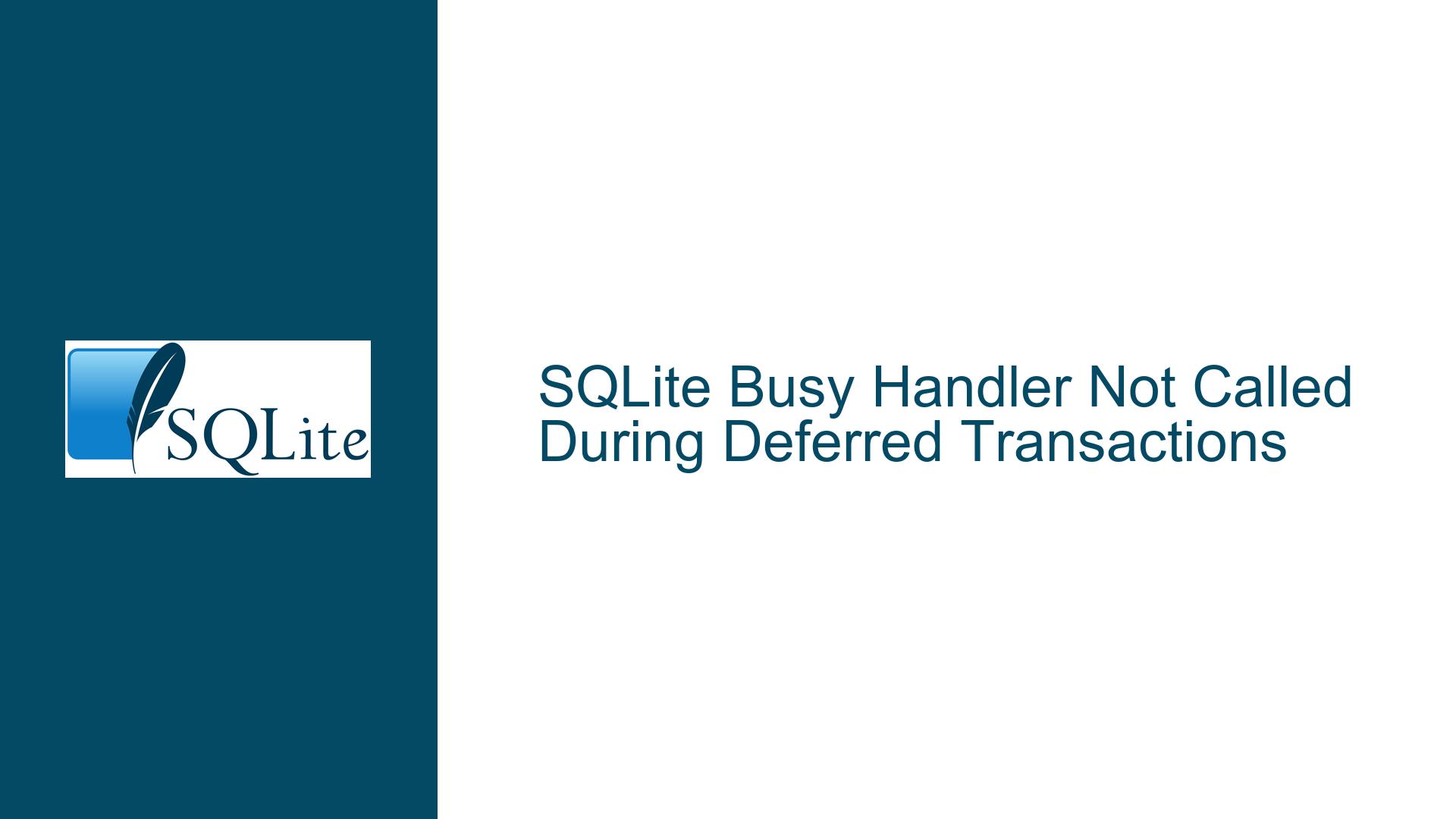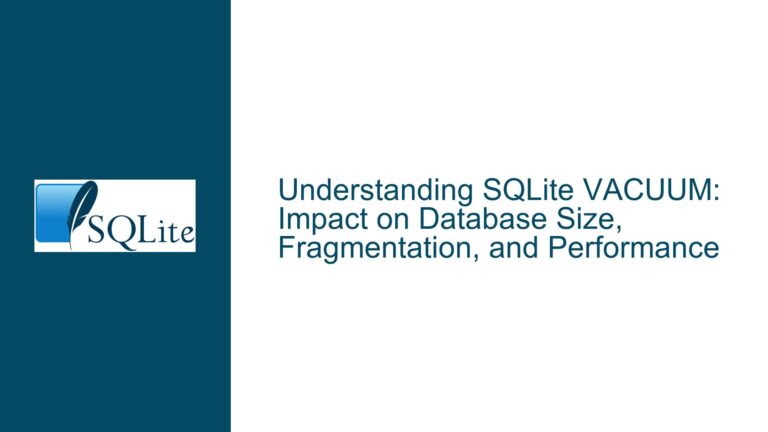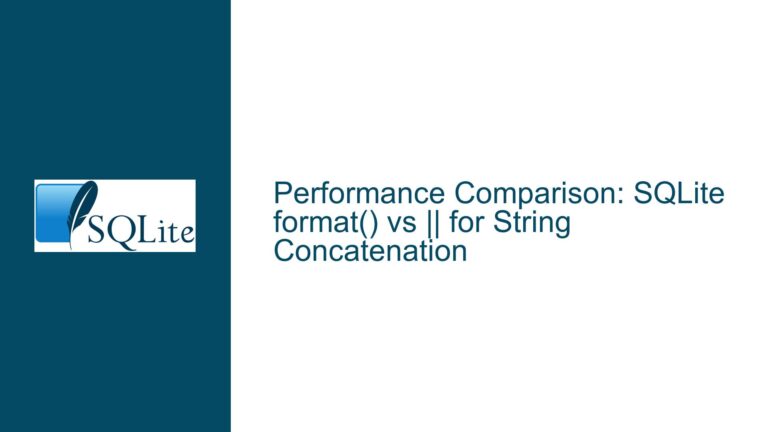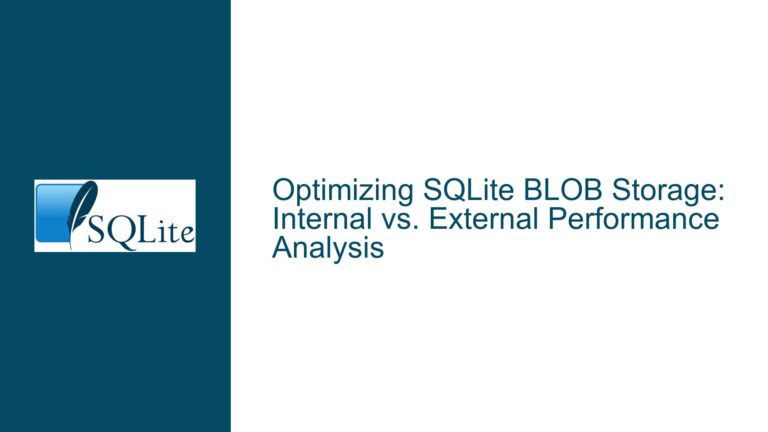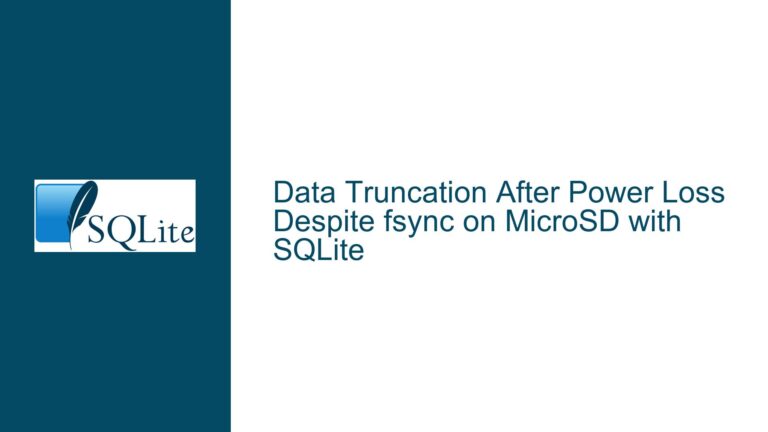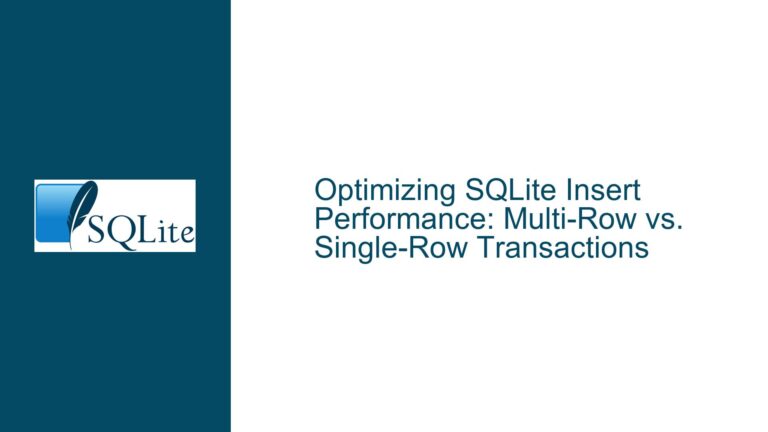SQLite Busy Handler Not Called During Deferred Transactions
SQLite Busy Handler Ignored in Deferred Transactions
In multi-threaded applications using SQLite, developers often encounter scenarios where the busy handler callback is not invoked during deferred transactions, leading to immediate SQLITE_BUSY errors. This issue arises when multiple database connections attempt to access the database simultaneously, particularly when transactions are initiated with BEGIN DEFERRED. The busy handler, which is designed to manage lock contention by retrying operations, is bypassed in certain conditions, causing confusion and requiring workarounds such as using BEGIN IMMEDIATE transactions.
The core of the problem lies in SQLite’s internal locking mechanism and its handling of deadlock scenarios. When a deferred transaction is initiated, SQLite acquires a shared lock, allowing multiple connections to read from the database concurrently. However, if one of these connections attempts to upgrade to a reserved lock for writing, it must wait for all shared locks to be released. If another connection also attempts to upgrade to a reserved lock while holding a shared lock, a deadlock occurs. SQLite detects this deadlock condition and returns SQLITE_BUSY without invoking the busy handler, as waiting would not resolve the deadlock.
This behavior is particularly problematic in applications where multiple threads or processes interact with the same database. The busy handler, which is expected to manage lock contention, is rendered ineffective in these scenarios, forcing developers to adopt alternative strategies such as using immediate transactions or restructuring their locking logic.
Deadlock Conditions in SQLite Locking Mechanism
The root cause of the busy handler not being called lies in SQLite’s deadlock detection and prevention mechanisms. SQLite employs a sophisticated locking system to ensure data integrity and consistency across multiple connections. When a deferred transaction is initiated, SQLite acquires a shared lock, allowing multiple connections to read from the database simultaneously. However, when a connection attempts to upgrade to a reserved lock for writing, it must wait for all shared locks to be released. If another connection also attempts to upgrade to a reserved lock while holding a shared lock, a deadlock condition arises.
In such a scenario, SQLite detects the deadlock and immediately returns SQLITE_BUSY without invoking the busy handler. This is because the deadlock cannot be resolved by waiting; it requires one of the connections to release its lock, which is not possible without external intervention. The deadlock condition is a classic example of a "circular wait," where each connection is waiting for the other to release a lock, resulting in a stalemate.
The use of deferred transactions exacerbates this issue, as they start with a shared lock and only upgrade to a reserved lock when a write operation is attempted. This creates a window of opportunity for deadlocks to occur, especially in high-concurrency environments. In contrast, immediate transactions start with a reserved lock, reducing the likelihood of deadlocks but at the cost of increased contention for write access.
Implementing Immediate Transactions and Busy Handler Best Practices
To address the issue of the busy handler not being called during deferred transactions, developers can adopt several strategies. The most effective solution is to use BEGIN IMMEDIATE transactions instead of BEGIN DEFERRED. Immediate transactions start with a reserved lock, which prevents other connections from acquiring shared locks and reduces the likelihood of deadlocks. This ensures that the busy handler is invoked when lock contention occurs, allowing the application to manage retries and delays effectively.
In addition to using immediate transactions, developers should consider the following best practices for implementing busy handlers in SQLite:
Custom Busy Handler Logic: Implement a custom busy handler that includes a retry mechanism with exponential backoff. This can help manage lock contention more effectively by gradually increasing the delay between retries, reducing the likelihood of repeated collisions.
Transaction Isolation Levels: Use appropriate transaction isolation levels to minimize lock contention. For example, using
BEGIN IMMEDIATEorBEGIN EXCLUSIVEcan help reduce the likelihood of deadlocks by acquiring stronger locks upfront.Connection Pooling: Implement connection pooling to manage database connections more efficiently. This can help reduce the number of concurrent connections and minimize lock contention.
Error Handling: Implement robust error handling to manage
SQLITE_BUSYerrors gracefully. This includes retrying the operation, rolling back the transaction, and restarting the process if necessary.Monitoring and Logging: Implement monitoring and logging to track lock contention and deadlock conditions. This can help identify patterns and optimize the application’s locking strategy.
By adopting these strategies, developers can mitigate the issue of the busy handler not being called during deferred transactions and ensure that their applications handle lock contention and deadlocks effectively. The use of immediate transactions, combined with custom busy handler logic and best practices for transaction management, can significantly improve the performance and reliability of multi-threaded SQLite applications.
Detailed Analysis of SQLite Locking and Deadlock Scenarios
To fully understand why the busy handler is not called in certain scenarios, it is essential to delve into the intricacies of SQLite’s locking mechanism. SQLite uses a combination of shared, reserved, and exclusive locks to manage concurrent access to the database. These locks are acquired and released at different stages of a transaction, depending on the type of operation being performed.
When a deferred transaction is initiated, SQLite acquires a shared lock, allowing multiple connections to read from the database concurrently. This shared lock is held until the transaction is committed or rolled back. If a connection attempts to perform a write operation, it must upgrade to a reserved lock, which requires all shared locks to be released. If another connection also attempts to upgrade to a reserved lock while holding a shared lock, a deadlock condition arises.
SQLite’s deadlock detection mechanism identifies this condition and immediately returns SQLITE_BUSY without invoking the busy handler. This is because the deadlock cannot be resolved by waiting; it requires one of the connections to release its lock, which is not possible without external intervention. The deadlock condition is a classic example of a "circular wait," where each connection is waiting for the other to release a lock, resulting in a stalemate.
In contrast, immediate transactions start with a reserved lock, which prevents other connections from acquiring shared locks and reduces the likelihood of deadlocks. This ensures that the busy handler is invoked when lock contention occurs, allowing the application to manage retries and delays effectively.
Practical Solutions for Managing Lock Contention in SQLite
To effectively manage lock contention and avoid scenarios where the busy handler is not called, developers can implement several practical solutions. These solutions focus on optimizing transaction management, improving error handling, and leveraging SQLite’s locking mechanisms to minimize contention.
Use Immediate Transactions: As discussed earlier, using
BEGIN IMMEDIATEtransactions can significantly reduce the likelihood of deadlocks by acquiring a reserved lock upfront. This ensures that the busy handler is invoked when lock contention occurs, allowing the application to manage retries and delays effectively.Implement Exponential Backoff in Busy Handlers: Custom busy handlers should include a retry mechanism with exponential backoff. This approach gradually increases the delay between retries, reducing the likelihood of repeated collisions and improving the overall efficiency of lock contention management.
Optimize Transaction Isolation Levels: Choosing the appropriate transaction isolation level can help minimize lock contention. For example, using
BEGIN IMMEDIATEorBEGIN EXCLUSIVEcan help reduce the likelihood of deadlocks by acquiring stronger locks upfront.Connection Pooling: Implementing connection pooling can help manage database connections more efficiently, reducing the number of concurrent connections and minimizing lock contention. Connection pooling ensures that connections are reused rather than created and destroyed frequently, which can help improve performance and reduce contention.
Robust Error Handling: Implementing robust error handling is crucial for managing
SQLITE_BUSYerrors gracefully. This includes retrying the operation, rolling back the transaction, and restarting the process if necessary. Proper error handling ensures that the application can recover from lock contention and continue operating smoothly.Monitoring and Logging: Implementing monitoring and logging can help track lock contention and deadlock conditions, providing valuable insights into the application’s locking behavior. This information can be used to optimize the application’s locking strategy and improve overall performance.
By adopting these practical solutions, developers can effectively manage lock contention in SQLite and avoid scenarios where the busy handler is not called. These strategies, combined with a deep understanding of SQLite’s locking mechanisms, can help ensure that multi-threaded applications operate efficiently and reliably.
Conclusion
The issue of the busy handler not being called during deferred transactions in SQLite is a complex problem rooted in the database’s locking mechanism and deadlock detection logic. By understanding the underlying causes and adopting best practices for transaction management and error handling, developers can mitigate this issue and ensure that their applications handle lock contention effectively. The use of immediate transactions, custom busy handlers with exponential backoff, and robust error handling are key strategies for managing lock contention and avoiding deadlocks in multi-threaded SQLite applications. With these approaches, developers can build reliable and efficient applications that leverage SQLite’s lightweight and powerful database engine.
